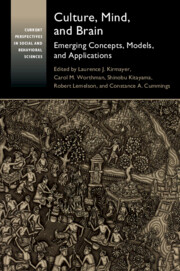Book contents
- Culture, Mind, and Brain
- Current Perspectives in Social and Behavioral Sciences
- Culture, Mind, and Brain
- Copyright page
- Dedication
- Epigraph
- Contents
- Figures
- Tables
- Contributors
- Preface
- Abbreviations
- 1 Introduction
- Part I Dynamics of Culture, Mind, and Brain
- Part II Applications
- 12 The Cultural Brain as Historical Artifact
- 13 Experience-Dependent Plasticity in the Hippocampus
- 14 Liminal Brains in Uncertain Futures
- 15 The Reward of Musical Emotions and Expectations
- 16 Literary Analysis and Weak Theories
- 17 Capturing Context Is Not Enough
- 18 Social Neuroscience in Global Mental Health
- 19 Cities, Psychosis, and Social Defeat
- 20 Internet Sociality
- 21 Neurodiversity as a Conceptual Lens and Topic of Cross-Cultural Study
- 22 Epilogue
- Index
- References
13 - Experience-Dependent Plasticity in the Hippocampus
from Part II - Applications
Published online by Cambridge University Press: 18 September 2020
- Culture, Mind, and Brain
- Current Perspectives in Social and Behavioral Sciences
- Culture, Mind, and Brain
- Copyright page
- Dedication
- Epigraph
- Contents
- Figures
- Tables
- Contributors
- Preface
- Abbreviations
- 1 Introduction
- Part I Dynamics of Culture, Mind, and Brain
- Part II Applications
- 12 The Cultural Brain as Historical Artifact
- 13 Experience-Dependent Plasticity in the Hippocampus
- 14 Liminal Brains in Uncertain Futures
- 15 The Reward of Musical Emotions and Expectations
- 16 Literary Analysis and Weak Theories
- 17 Capturing Context Is Not Enough
- 18 Social Neuroscience in Global Mental Health
- 19 Cities, Psychosis, and Social Defeat
- 20 Internet Sociality
- 21 Neurodiversity as a Conceptual Lens and Topic of Cross-Cultural Study
- 22 Epilogue
- Index
- References
Summary
Life experiences have been associated with significant changes in brain structure and functioning. This experience-dependent plasticity is thought to reflect the capacity of our nervous systems to adapt to environmental demands, and ultimately shape cognition. This chapter focuses on how such experiences and environment can specifically impact the hippocampus, a structure important for learning, memory, and healthy cognition. The hippocampal memory system maintains a competitive relationship with other memory systems, in particular the caudate nucleus of the striatum, part of the basal ganglia. Specific types of behavior, such as spatial-based vs. response-based navigational strategies, can influence these memory systems both positively and negatively and lead to long-term neuroplastic changes. Overreliance on non-hippocampus dependent navigational strategies is associated with a reduction in hippocampus volume and activity across the lifespan. Emerging research is now pointing to the wide use of electronic devices – GPS, smartphones, and video games – as a contributing factor to greater reliance on non-hippocampus dependent memory. Given the limited, but concerning, evidence that reliance on electronic devices can interact with already established factors related to underuse of the hippocampal memory system, further study is needed to better understand how these imbalances occur and how they can be mitigated.
Keywords
- Type
- Chapter
- Information
- Culture, Mind, and BrainEmerging Concepts, Models, and Applications, pp. 375 - 388Publisher: Cambridge University PressPrint publication year: 2020

